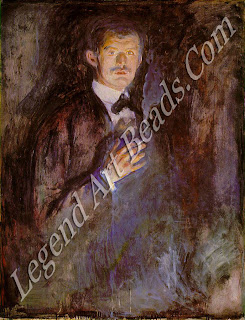
EDVARD
MUNCH
1863-1944
Edvard
Munch was Norway's greatest painter and graphic artist, a major exponent of
Symbolism and a forerunner of the Expressionists. The tragic loss of his mother
and sister in his childhood brought a morbid tone to much of his work.
Initially, his friendship with the bohemian circle in the Norwegian capital
steered him towards Impressionism, but trips to Paris from 1889 onwards put him
in touch with the Symbolists.
In
1892, Munch's name was made when his exhibition in Berlin was closed down,
bringing him instant notoriety. Settling in Germany, he embarked on his Frieze
of Life, a compilation of intensely personal images of love and death.
Overwork, alcohol and emotional strain led Munch to a nervous breakdown in
1908. After this, he returned to live in seclusion in Norway, devoting his last
years to public murals and studies of workers.
THE EDVARD MUNCH 'S LIFE
A Mind in Torment
Traumatic
childhood experiences created in Munch a chronic anxiety and restlessness,
leading ultimately to a nervous breakdown. After this, he returned to his
native Norway to recuperate and settle.
Edvard
Munch was born on 12 December 1863, in Loten, a small farming community in
southern Norway. His father, Christian, came from a professional background of
churchmen and soldiers and worked as a military physician. Christian's brother,
Peter Andreas Munch, was a celebrated historian.
Edvard
was the second son of five children. A year after his birth, the family moved
to the capital, Christiania (re-named Oslo in 1927), where tragedy was to enter
their lives. In 1868, Munch's mother died of tuberculosis at the age of 33 and,
in 1877, his favourite sister Sophie also perished from the same disease. These
early misfortunes scarred the boy deeply, and throughout his long career,
images of the sick room and the deathbed recur constantly in his work.
Munch's
home life was claustrophobic and oppressive. A sickly child himself, he was
confined within the family flat for considerable periods of his youth, while
his father's religious fervour, which had intensified after the death of his
wife, was bringing him to the brink of insanity for hours at a tune, he would
pace up and down his room in prayer. Small wonder that Munch later wrote of his
childhood, 'Illness, madness and death were the black angels that kept watch
over 6 my cradle and accompanied me all my life.
Fortunately,
his aunt Karen had taken over the running of the family and was to prove a stabilizing
influence. As an amateur painter, she encouraged the Munch children to draw.
Accordingly, Edvard made copies of the illustrations in Grimm's fairy tales
and, in the early 1880s, was trying to sell his work to magazines.
Key Dates
1863 born in Loten, southern
Norway
1868 mother dies
1877 sister dies
1881-3 attends State School of
Art and Crafts
1885/6 paints The Sick
Child
1889-91 scholarship to study in
Paris
1892 Berlin exhibition closed
1906 designs theatre sets for
lbsen's Ghosts
1908 suffers a nervous
breakdown
1909 settles in Norway
1916 his murals installed at
Christiania (Oslo) University
1937 his paintings confiscated by
the Nazis
1944 dies at Ekely
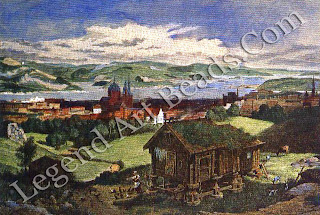 By this
time, he had already decided on art as a career. His studies in engineering at
the Technical College had lasted less than a year and, in 1881, he entered the
State School of Art and Crafts. His initial supervisor there was Julius
Middelthun, but the dominant influence on his early development was the
naturalist painter, Christian Krohg. In 1882, along with six other artists,
Munch rented a studio where Krohg provided informal instruction.
By this
time, he had already decided on art as a career. His studies in engineering at
the Technical College had lasted less than a year and, in 1881, he entered the
State School of Art and Crafts. His initial supervisor there was Julius
Middelthun, but the dominant influence on his early development was the
naturalist painter, Christian Krohg. In 1882, along with six other artists,
Munch rented a studio where Krohg provided informal instruction.
Through
Krohg, Munch also came into contact with the bohemian circle of writers and
painters who were in the forefront of artistic rebellion in Norway. Led by
Krohg and the novelist Hans Jaeger, the group denounced bourgeois morality and
pressed for radical, sexual and artistic freedom. In literature, they
worshipped Zola and, in painting, they advocated an unstinting brand of
realism. One commentator summed them up as 'that half-debauched,
poverty-stricken, Christiania gypsy camp'.
Norway,
however, was too provincial a platform for Munch's talents. In 1883, he
attended the open-air academy run by Gauguin's brother-in-law, Frits Thaulow,
and through him gained a travel grant to Paris two years later. The visit
lasted only three weeks, but gave him the opportunity to see most of the latest
works by Monet and the Impressionists.
Some
Parisian influences can be detected in Munch's first masterpiece, The Sick
Child, which was completed in 1886. However, the scraping away of the features
and the slightly simplified forms created a more powerful emotional impact than
most Impressionist paintings, and are reminiscent of Post-impressionist masters
like Vuillard and Ensor.
A SCHOLARSHIP TO PARIS
Four
years later, Munch was able to study French art at greater leisure. After the
success of his first one-man show, the Norwegian government awarded him a State
Scholarship on condition that he found an acceptable teacher. Accordingly, on
his arrival in Paris, he enrolled in the life classes of Leon Bonnat.
Munch
worked diligently at these classes, but was soon alienated by his master's
conventional academic approach. Bonnat, in turn, was impressed with his pupil's
draughtsmanship, but objected to his highly subjective use of colour. The two
men parted company after a disagreement over the precise tones of a wall in the
studio.
Despite
this setback, Munch's three-year stay in Paris was a crucial period. The death
of his father in 1889 released him from lingering family ties while, on a more
positive note, he benefited enormously from the feverish activity in the art
world. He was particularly influenced by the growing Symbolist movement, which
inspired his symbolic use of colour, his simplification of form, and even his
subject matter of the femme fatale.
 Meanwhile,
a dramatic incident brought Munch international attention. In 1892, the Verein
Berliner Kunstler (Union of Berlin Artists) invited him to join their
exhibition. His paintings caused uproar and, after a week, the committee
ordered him to remove his 'daubs'. But some of the Verein's members objected
and, headed by Max Liebermann, left to form the Berlin Secession.
Meanwhile,
a dramatic incident brought Munch international attention. In 1892, the Verein
Berliner Kunstler (Union of Berlin Artists) invited him to join their
exhibition. His paintings caused uproar and, after a week, the committee
ordered him to remove his 'daubs'. But some of the Verein's members objected
and, headed by Max Liebermann, left to form the Berlin Secession.
Munch
was delighted by the furore and swiftly made arrangements to exhibit the works
in Dusseldorf and Cologne. An extensive tour of German and Scandinavian cities
followed and, through these shows, Munch earned as much from his percentage of
the entrance fees as he did from the sales of his paintings. Encouraged by this
sudden notoriety, Munch settled in Berlin and soon became attached to a new
artistic coterie, which met at Zum Schwarzen Ferkel (the Black Piglet). Among
its more vocal members were the playwright August Strindberg, and the Polish
novelist Stanislaw Przybyszewski.
Amid
the highly charged atmosphere of the group's meetings, Munch formulated plans
for his Frieze of Life. Through this ambitious scheme, he intended to assemble
a number of paintings on linked themes and display them together, in the hope
that the ensemble would create a symphonic effect. The binding theme was to be
'the poetry of life, love and death', seen through the distorting mirror of
Munch's personal experiences, and the series included many of his greatest
paintings. The Scream, The Dance of Life, Madonna (back cover), The Vampire and
Jealousy were among the works selected.
THE MEANING OF THE FRIEZE
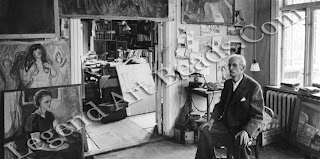 At the
core of the Frieze was Munch's view of female sexual power. He depicted this in
three stages as awakening innocence, voracious sexuality and as an image of
death. In many cases, these three facets were combined in a single picture. The
lithograph of Madonna (back cover), for example, suggested innocence through
its title and the sketchy halo, and yet at the same time Munch chose to show
the woman at the point of orgasm and described her expression as a 'corpse's
smile'. Meanwhile, in the border, sperm wriggled like worms away from a sickly
embryo.
At the
core of the Frieze was Munch's view of female sexual power. He depicted this in
three stages as awakening innocence, voracious sexuality and as an image of
death. In many cases, these three facets were combined in a single picture. The
lithograph of Madonna (back cover), for example, suggested innocence through
its title and the sketchy halo, and yet at the same time Munch chose to show
the woman at the point of orgasm and described her expression as a 'corpse's
smile'. Meanwhile, in the border, sperm wriggled like worms away from a sickly
embryo.
Munch's
own relations with women reflected these troubled images. Although tall and
good looking, he was wary of the opposite sex: the loss of his mother and
sister may have made him afraid of relationships with women he often portrayed
love and death together. The family history of tuberculosis and mental illness
convinced him it was unwise to marry, but he also feared marriage would
interfere with his work. His first affair, with the headstrong wife of a
medical officer, haunted him for years, while, in Berlin, he was attracted by
Przybyszewski's wife, Dagny, and portrayed her as a temptress in Jealousy. His
final, disastrous liaison with Tulla Larsen ended with her shooting off the
joint of one of his fingers.
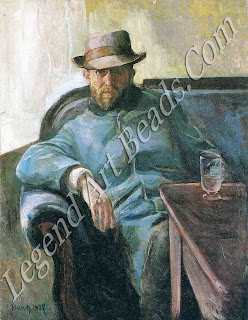
Although
based in Germany, Munch travelled frequently, living in a succession of
boarding houses. He was not a healthy man and his nomadic lifestyle must have
mentally and physically exhausted him. Money was also a problem and, on one
occasion, a patron rescued Munch after he had been evicted from his room and
was forced to wander the streets of Berlin for three days without food.
Nevertheless,
these were productive years. On a visit to Paris Munch met Paul Gauguin and his
followers and, at Bing's Art Nouveau gallery, he saw the influential exhibition
of Japanese woodcuts. Also in Paris, he developed his interest in new printing
techniques, under the supervision of the renowned graphic artist, Auguste Clot.
IMPORTANT COMMISSIONS
Munch's
major commissions at the turn of the century came from his friend, Dr Linde. In
addition to a superb portrait of the doctor's four sons, the artist completed a
folio of prints for him and drew up plans for a frieze to decorate his nursery.
The latter was never executed; however, as Linde eventually decided that
Munch's work might not be suitable for his children's room.
In
1906-7, he gained several other important commissions from Max Reinhardt, to
provide a frieze for his new Kammerspiele theatre and design sets for lbsen's
Ghosts and Hedda Gabler. While he was working on these pictures, Munch lived in
the theatre, painting by day and drinking by night. He kept himself remote from
other people, causing a colleague to admit that 'He remained both a stranger
and a puzzle to us'.
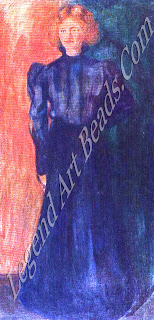 The
shooting incident with Tulla Larsen, excessive drinking and exhaustion began to
take their toll, and Munch became obsessed with feelings of persecution which
were not helped by the abusive criticism of his work by his countrymen.
Finally, in 1908, after a three-day drinking spree, he suffered a nervous
breakdown and was admitted to Daniel Jacobson's clinic in Copenhagen. There, he
recuperated for eight months, receiving various forms of therapy.
The
shooting incident with Tulla Larsen, excessive drinking and exhaustion began to
take their toll, and Munch became obsessed with feelings of persecution which
were not helped by the abusive criticism of his work by his countrymen.
Finally, in 1908, after a three-day drinking spree, he suffered a nervous
breakdown and was admitted to Daniel Jacobson's clinic in Copenhagen. There, he
recuperated for eight months, receiving various forms of therapy.
Munch
had always been aware of the danger inherent in allowing his creativity to feed
off his neuroses, but chose to ignore it. 'I would not cast off my illness' he
had written 'for there is much in my art that I owe to it.' Now, however, he
dedicated himself to recovery. In doing so, he made a conscious decision to
abandon the obsessive, neurotic imagery of the past. Henceforward, he would
depict the things he saw around him, rather than his emotions.
In
addition, Munch resolved to put an end to his wandering.. Hitherto, he had
spent only his summers in Norway, at Asgardstrand, but now he returned there
permanently, settling at first in the coastal town of Kragero.
Ironically,
the ending of Munch's most creative period coincided with greater official
recognition. In 1908, he was made a Knight of the Order of St Olav and, in 1911,
he won the prestigious competition for decorating the University Assembly Hall.
Here, he installed a new Frieze of Life, although this time he chose to portray
universal forces The Sun, History, Alma Mater rather than the inner workings of
the soul.
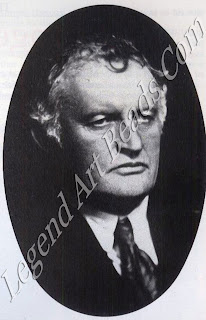 FINAL PROJECTS
FINAL PROJECTS
Munch
aimed to produce further public murals. In particular, he cherished the idea of
designing a frieze on the theme of working men and industry. Preliminary
sketches were displayed in the dining room of the Freia Chocolate Factory in
1922 but, sadly, the project never materialized. Munch also offered his
services for the decoration of the new City Hall in Oslo, but the building work
was delayed until 1933, by which time the artist had an eye complaint and could
no longer paint.
Munch's
last years were spent in isolation at his estate in Ekely. Here, he lived a Spartan
life, surrounded by the paintings which he called his 'children'. Despite this
term of affection, he treated them badly, littering his prints on the floor and
hanging his paintings out on the apple trees to dry. With the rise of the
Nazis, Munch's art was branded as degenerate and his pictures sold off from
German museums. Then, in December 1943, he contracted a fatal dose of
bronchitis after a bomb blew out the windows of his house. He died on 23
January 1944. In his will, he generously bequeathed his entire collection of
prints and paintings some 20,000 in all to the city of Oslo.
Writer
– Marshall Cavendish

 By this
time, he had already decided on art as a career. His studies in engineering at
the Technical College had lasted less than a year and, in 1881, he entered the
State School of Art and Crafts. His initial supervisor there was Julius
Middelthun, but the dominant influence on his early development was the
naturalist painter, Christian Krohg. In 1882, along with six other artists,
Munch rented a studio where Krohg provided informal instruction.
By this
time, he had already decided on art as a career. His studies in engineering at
the Technical College had lasted less than a year and, in 1881, he entered the
State School of Art and Crafts. His initial supervisor there was Julius
Middelthun, but the dominant influence on his early development was the
naturalist painter, Christian Krohg. In 1882, along with six other artists,
Munch rented a studio where Krohg provided informal instruction.  Meanwhile,
a dramatic incident brought Munch international attention. In 1892, the Verein
Berliner Kunstler (Union of Berlin Artists) invited him to join their
exhibition. His paintings caused uproar and, after a week, the committee
ordered him to remove his 'daubs'. But some of the Verein's members objected
and, headed by Max Liebermann, left to form the Berlin Secession.
Meanwhile,
a dramatic incident brought Munch international attention. In 1892, the Verein
Berliner Kunstler (Union of Berlin Artists) invited him to join their
exhibition. His paintings caused uproar and, after a week, the committee
ordered him to remove his 'daubs'. But some of the Verein's members objected
and, headed by Max Liebermann, left to form the Berlin Secession.  At the
core of the Frieze was Munch's view of female sexual power. He depicted this in
three stages as awakening innocence, voracious sexuality and as an image of
death. In many cases, these three facets were combined in a single picture. The
lithograph of Madonna (back cover), for example, suggested innocence through
its title and the sketchy halo, and yet at the same time Munch chose to show
the woman at the point of orgasm and described her expression as a 'corpse's
smile'. Meanwhile, in the border, sperm wriggled like worms away from a sickly
embryo.
At the
core of the Frieze was Munch's view of female sexual power. He depicted this in
three stages as awakening innocence, voracious sexuality and as an image of
death. In many cases, these three facets were combined in a single picture. The
lithograph of Madonna (back cover), for example, suggested innocence through
its title and the sketchy halo, and yet at the same time Munch chose to show
the woman at the point of orgasm and described her expression as a 'corpse's
smile'. Meanwhile, in the border, sperm wriggled like worms away from a sickly
embryo.  The
shooting incident with Tulla Larsen, excessive drinking and exhaustion began to
take their toll, and Munch became obsessed with feelings of persecution which
were not helped by the abusive criticism of his work by his countrymen.
Finally, in 1908, after a three-day drinking spree, he suffered a nervous
breakdown and was admitted to Daniel Jacobson's clinic in Copenhagen. There, he
recuperated for eight months, receiving various forms of therapy.
The
shooting incident with Tulla Larsen, excessive drinking and exhaustion began to
take their toll, and Munch became obsessed with feelings of persecution which
were not helped by the abusive criticism of his work by his countrymen.
Finally, in 1908, after a three-day drinking spree, he suffered a nervous
breakdown and was admitted to Daniel Jacobson's clinic in Copenhagen. There, he
recuperated for eight months, receiving various forms of therapy. 
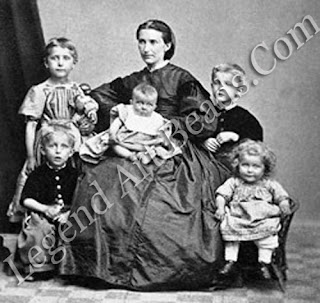
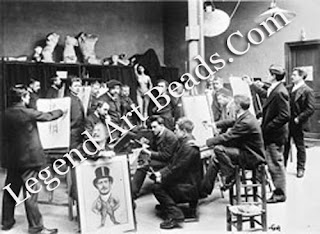













0 Response to "The Great Artist Edvard Munch"
Post a Comment